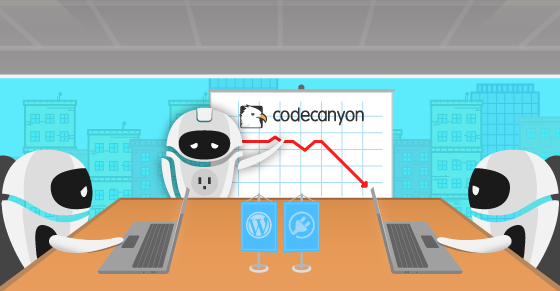|
|
Owned by Envato, a digital marketplace conglomerate, CodeCanyon is the leading marketplace for selling premium WordPress plugins. The marketplace grossed over $70,000,000 since 2009, processed 2.3 million sales of WordPress plugins, and has a growing community of 7.8 million members.
After seeing relatively optimistic results in the previous post where I analyzed ThemeForest, this post focuses on the CodeCanyon marketplace, trying to dive into its unit economics and understand what are the chances of “making a living” by using it to sell premium WordPress plugins.
What is CodeCanyon?
CodeCanyon was Envato’s 6th marketplace launched in 2009 which focuses on scripts and plugins. The first item was listed in June 2009, a jQuery plugin called Zoomer. The first CodeCanyon WordPress plugin was published only a year later (June 2010) by Wim Mostmans from Belgium (if you’re curious, that’s the link to the plugin Owit with Myows).
How Big is WordPress on CodeCanyon?
CodeCanyon Plugins & Scripts Inventory
From a total of 19,006 scripts and plugins on CodeCanyon, 4,861 (or 26%) are premium WordPress plugins.

CodeCanyon Sales
Since 2009, the CodeCanyon marketplace processed a total of transactions worth $75,207,173. Out of those transactions, $53,906,191 are exclusively for WordPress plugins.
Out of $75,207,173, CodeCanyon grossed $53,906,191 for WordPress Plugins.

While representing only 25.5% of all plugins on CodeCanyon, WordPress plugins are driving 71.7% of the total revenues.

CodeCanyon Marketplace ARR (Annual Recurring Revenue)
Based on CodeCanyon’s sales history and the average monthly sales per item, CodeCanyon GMV (Gross Merchant Volume) on 2017 will be $29,160,101. WordPress plugin sales will generate $18,658,758 of that pie.
It may seem odd that 2017 alone is expected to yield almost an amount that is equal to 40% of the total $75M sold on CodeCanyon from 2009 to 2016, but that’s a totally reasonable growth rate, considering that Envato almost doubled its subscribers list from 4M to 7.6M members. Most of those members are buyers, so that’s where the “new” money is coming from.

We see that the total GMV of WordPress plugins is 72% while the ARR in 2017 is 8% less. That’s a significant drop, which means that the WP plugins are shrinking into a smaller piece of the CodeCanyon pie. Having said that, WordPress is still, by far, the most profitable platform on the CodeCanyon marketplace. I think it will be interesting to track it and see if this trend continues.
How Popular is CodeCanyon Among Developers?
The best way to understand the popularity trend of a plugins marketplace such as CodeCanyon is by looking at its inventory:

During 2015, 7,588 new plugins were listed on WordPress.org, 722 of them with a freemium business model, and 50 with a premium version on CodeCanyon. During the same year, 1096 new premium WordPress plugins were listed on CodeCanyon. A reasonable assumption is that no more than an additional 7,588 other plugins were released outside the WordPress.org repository, on repositories like GitHub and BitBucket, on other WordPress plugin marketplaces like Mojo and Codester, as well as plugins hosted privately by companies and developers (excluding custom-made plugins for clients). This means that 2016 yielded a total of up to 16,000 new WP plugins. We know for sure that at least 1,768 of them are premium (CodeCanyon + freemium plugins on WordPress.org). I would bet that at least another 300 premium only plugins/add-ons were created in addition.
Bottom line is that at least 13% of the new plugins added to the WordPress ecosystem during 2015 were premium plugins. That’s a strong signal demonstrating how the WordPress ecosystem, as a whole, is maturing.
13% of the new plugins added to the WordPress ecosystem during 2015 were premium WordPress plugins.
Note: In the calculations above, I assumed that all premium WordPress plugins that were added to CodeCanyon during 2015 were also new plugins. That’s not always the case, some developers can list their plugin on the marketplace at a later stage in the plugin’s lifecycle.

In the past 2 years, CodeCanyon almost doubled its WordPress plugins inventory. Having said that, it looks like CodeCanyon reached to a plateau, in terms of inventory growth. Since September 2013, an average of 97 new WP plugins are listed every month on CodeCanyon (ranging between 70-130 new WordPress plugins per month).
It’s also interesting to see that, since 2014, October and November are consistently the “hot” months with more WordPress plugins being submitted to CodeCanyon. I think that it’s actually related to Envato’s plugins provisioning process. My guess is that CodeCanyon’s plugins review team is working harder to try and clean the “review queue” and approve more plugins before the holidays’ vacation.
Can You Build a Sustainable Plugins Business on CodeCanyon?
There is a bunch of stories by CodeCanyon authors that share their experience (Google “what I learned from selling on codecanyon”). Some of them have had positive experiences, others not so much. Those publicly available breadcrumbs are nice, but it’s very hard to see the whole picture and understand how many success stories are there, compared with failures. Additionally, CodeCanyon is already 7 years old. Starting to sell plugins on CodeCanyon today is very different from what it used to be 3 or 5 years ago.
CodeCanyon’s WordPress Whales
3 of the 19,001 plugins & scripts on CodeCanyon crossed the $1M threshold in total sales. All three are WordPress plugins. Assuming Envato’s commission is 30%, since 2009 CodeCanyon turned only 2 plugin authors into millionaires.
3 of CodeCanyon’s 19,001 items had crossed $1M in total sales – all three are WordPress plugins.
Visual Composer is by far the most popular WP plugin on CodeCanyon. It crossed $7,000,000 in gross revenues, and the developers took home over $4,000,000 in earnings (before taxes). Based on its sales history, the Visual Composer team is collecting around $79,000 every month for this one plugin. Not bad at all, but not extraordinary when compared to other successful plugin businesses outside CodeCanyon (e.g. Yoast, NextGEN Gallery, Gravity Forms, iThemes).
The top 20 WordPress plugins on CodeCanyon are responsible for 17% ($4,943,141) of the total annual sales of all plugins & scripts sold on CodeCanyon – that’s huge! 19 out of those 20 are WordPress plugins.
Pricing Distribution of WordPress Plugins on CodeCanyon
A great way to understand a marketplace is to analyze its price distribution.
The average price of a WordPress plugin on CodeCanyon is $18.91, while prices are ranging from $5 to $299 for the most expensive plugin.

11% of the WordPress plugins on CodeCanyon are priced at $15 (the most popular price).
The most popular price for a WordPress plugin on CodeCanyon is only $15 (11% of all plugins).
98.2% of the WordPress plugins on CodeCanyon are priced under $40 (93% priced at $30 and below). Those are ridiculously low prices for plugin developers, especially since plugins are usually heavy in terms of support, due to a wide variety of environments and possible plugins/themes combinations & conflicts on WordPress websites. Only 5 plugins priced above $100 (0.1%).
98.2% of the WordPress plugins on CodeCanyon are priced under $40 (93% priced at $30 and below).
With the new Author Driven Pricing (ADP), Envato is now charging a $4 Buyer’s Fee for every WP plugin transaction. That’s in addition to an Author Fee starting from 37.50% to 12.50%. If we take the $18.91 average transaction for a WordPress plugin on CodeCanyon, on average, a WordPress plugin developer on CodeCanyon earns between $9.31 to $13.04. If we add taxes, it means less than $10 per sale.
An average earn out for a WordPress plugin sale on CodeCanyon is less than $10, after taxes.
How Many Licenses of Your WordPress Plugin Should You Expect to Sell on CodeCanyon?
Based on CodeCanyon’s historical data – 61.6% of the WordPress plugins sold less than 100 licenses from the day they were released. The vast majority (4,499 / 92.55% plugins) sold less than 1,000 licenses.
Only 24 of the WordPress plugins sold more than 10,000 licenses. That’s less than 0.5%.
Then, I wanted to understand if spending more time in the marketplace necessarily means more sales, and how many. Therefore, I plotted the median sales per month over the total number of months the plugin was listed in the marketplace. Median is the number in the middle of a sorted group of numbers. It’s a good way to show the “average” sales number in a large enough data set, while excluding the noise from the calculations by ignoring the exceptionally successful, as well as plugins with exceptionally poor performance.

Analyzing this chart shows that if you choose to sell a premium WordPress plugin on CodeCanyon, on average you can expect a steady 2-4 license sales per month during the first year. This is surprisingly low. If we take into account the average earning from a sold license after taxes (under $10), even if the plugin is doing exceptionally well (in that average range), the top you can earn from a WP plugin on its first year on CodeCanyon is $480 (on average).
The max average earnings for a WP plugin on CodeCanyon during its first 12 months is under $500.
It’s important to note that those are medians and averages, so there are definitely plugins that earn more than that during their first year on CodeCanyon. Let’s use a magnifying glass:
- 99 plugins in that cohort didn’t sell any copies.
- 89 plugins sold one license.
- 451 plugins sold between 2-10 licenses.
- 435 plugins sold between 11-100 licenses.
- 295 plugins sold more than 100 licenses.

During the initial $7,500 of a plugin’s lifetime revenue, the Authors Fee for new authors is 37.5%-35%, and the Buyer Fee is a flat $4 per license. Assuming a flat 30% for taxes, 84% of the plugins in that cohort earned below $500 (after taxes). Only 5 plugins earned more than $10,000 during the first year.
Only 5 WP plugins added to CodeCanyon during the past 12 months crossed $10K in earnings (after taxes).
Does Being Early in The Marketplace Matter And to What Extent?
Performance of Plugins Listed Under 2 Years on CodeCanyon
51% (2,462) of the WordPress plugins on CodeCanyon were listed during the past 2 years. Even though they are the majority, they only generated 11.29% of the total gross sales ($6,087,730).
The top selling WordPress plugin from this cohort earned ~$131,094 after Envato’s commissions ($187,278 before commissions).
On average, each plugin had driven only a total of $2,472 in sales ($1,730 after commissions).
Performance of Premium WordPress Plugins Listed for 2-3 Years on CodeCanyon
I’ve done the same analysis on the 2-3 year old WP plugins (1,061 – 22%) and there’s already a huge difference. The average total sales of plugins that were listed between 2-3 years ago is 5.2 times higher ($12,855) than plugins that have been listed for less than 2 years. The top selling plugin from that group earned ~$444,511 ($635,017 gross before commissions). This group drove 25.3% of the total sales for CodeCanyon.
Performance of Premium WordPress Plugins Listed for 3-4 Years on CodeCanyon
Surprisingly, the average gross revenues of plugins that were listed on CodeCanyon 3-4 years ago is slightly lower than their sibling plugins added a year before that – $12,121 vs. $12,855. Additionally, the most successful plugin in that group generated $42,000, which is less than what the most successful plugin in the 2-3 year old plugins group had generated.
Performance of Premium WordPress Plugins Listed for 4 Years or More on CodeCanyon
Not surprisingly, the smallest group of 588 plugins (12%) that have been listed for more than 4 years drove 46.54% of the total market sales ($25,088,242). An average WP plugin in that group generated $42,667 of gross revenues during its lifetime – 17.2 times more than an average plugin listed during the past 24 months. Plus, the top 10 selling plugins in the marketplace (except one) belong to this group.
CodeCanyon WordPress Plugins Monthly Earnings
97.6% of the WordPress plugins on CodeCanyon earn below $1,001 per month (before taxes), assuming the commission is only 30%. That’s 4,743 out of 4,861 plugins. In fact, the numbers are even worse since the average commission ranges from 32.5% to 75%.

Only 7 of the WordPress plugins on CodeCanyon cross the $10,000 in monthly earnings. That’s less than 0.15%.
CodeCanyon Average Plugin Annual Sales
The average annual gross sales for a script or a plugin on CodeCanyon is only $1,534. If we look at WordPress plugins, the average annual sales is $3,838. That’s around $2,686 a year in earnings. That’s $224 per month, a number that makes it extremely hard (more like impossible) to sustain yourself, even in eastern countries.
What is the Lifetime Value of An Average WordPress Plugin on CodeCanyon?
It’s hard to conclude for how long an average WordPress plugin is still relevant and making sales based on the data we pulled from Envato’s public API. From my experience, as long as the plugin is supported, maintained and kept up to date, sales will keep on coming (not necessarily grow).
Based on the Bureau of Labor Statistics, most businesses don’t last more than 5 years:

So let’s examine an average case where a WordPress plugin is sold exclusively by a new author on CodeCanyon for 5 years straight to see what to expect with current Envato fees.
5 years of annual average $3,838 gross sales yield $19,190 in total gross. Let’s see how much commission goes to Envato for that amount:

The % Buyer Fee is calculated based on the average price of a WordPress plugin ($4 out of $18.9).
And here’s the NET earnings chart when combining those fees:

If you do choose to sell plugins exclusively on CodeCanyon, the rev-share is gradual. The more you generate in total gross, the less commission you pay starting from 52% to 32%. In this case, after 5 years on CodeCanyon you are expected to generate only $9,848 net earnings (before taxes).
The 5-year lifetime value of an Avg. WordPress Plugin sold exclusively on CodeCanyon is only $9,848.
Bottom Line
When I started this CodeCanyon research I was very optimistic. Unfortunately, the numbers revealed a very hard truth. Based on the analysis, the chance for a new plugin author today to earn more than $1,000 a month just by listing a plugin on CodeCanyon is less than 3%. The chance to earn more than $10,000 during the first 12 months is less than 0.4%. Ouch…
Only 1 of 274 new plugins submitted to CodeCanyon will pass $10K earnings during the first 12 months
Again, it is possible, and there are still new plugins that do make it, but you need to be exceptional (1 out of 274), and will probably have to heavily market it yourself. I spoke with a few successful CodeCanyon sellers, many of them confirmed that over 50% of the sales are driven by their marketing efforts (traffic sources are transparent to Envato Elite Authors).
Are There Better CodeCanyon Alternative Marketplaces for Selling Premium WordPress Plugins?
The historical data from CodeCanyon reveals how bleak is the WordPress plugin marketplace business. Statistically, if you cannot build a successful business on the leading marketplace, you won’t be able to make that happen on any of the other popular plugin marketplaces (e.g. Mojo Marketplace, WP Eden, Codester).
The premium plugins market is already exchanging hundreds of millions of dollars every year, and is rapidly growing. Based on the numbers, it seems like the traditional marketplace model just doesn’t work well for plugins. Most of the popular WordPress plugin marketplaces, including CodeCanyon, started as marketplace companies for web designs/templates/themes. Plugins were added to the inventory without adjusting the marketplaces business models and sale tactics. As a side note, I personally think there’s a huge opportunity to disrupt it.
Grab a free copy of our Cheat Sheet for
Selling Plugins and Themes
A growth roadmap with concise, actionable tips for every milestone of WordPress product development.

Is There A Better Way to Sell WordPress Plugins?
If you are just starting out with premium plugin development, CodeCanyon could be a nice place to test your offering, learn a bit about your competitive landscape, and see if your paid WordPress plugin gets any traction at all. But, if you want to sustain yourself from plugin development or build a real business, the odds of getting there with CodeCanyon are very-very low.
What Are The Main Benefits of Selling Plugins Outside of CodeCanyon?
Keeping A Larger Piece of The Pie
CodeCanyon charges somewhere between 32.5%-70% commission (starting with at least 37.5% + $4 per transaction, for the initial $3,750 sales) for distributing and marketing your WordPress plugins. It might sound outrageous, but I think it’s a fair game considering that Envato provides you with access to a large community of potential buyers and does (some of) the marketing for you. Also, it makes sense that the initial commission is higher since the onboarding of plugin authors is more expensive than the ongoing costs (e.g. running code review on your plugin before it’s officially released to the marketplace). Now if you sell plugins on your own, you are obviously playing by your own rules and don’t need to pay a premium commission for your plugin sales.
You Don’t Compete On Price
Even though you can now set up your own prices on CodeCanyon, you are still competing with 5,000 other plugins in the marketplace so it would be hard to charge $100 (the average annual single-site price of plugins sold independently, outside of marketplaces) for an item where the average price point is only $18.9. On the other hand, when a visitor goes on your site, it’s up to your marketing page to “convince” them your plugin is worth the $100. You are not competing with other plugins in the same category just a click of a button away.
Pricing your WordPress plugins properly is an art, though the fundamental concepts are quite straightforward. Check out these 5 insightful tips on how to price a product or a service for the WordPress market.
Recurring Revenues and Automatic Renewals
CodeCanyon is currently limited to one time payments for lifetime updates. As a plugin business owner myself, I believe that free lifetime updates for plugins is a ridiculous concept, considering the WordPress environment. In order for the plugin to stay relevant and continue working, plugin developers have to continue maintaining coding standards, patch new security vulnerabilities, and adjust to new WordPress releases. Furthermore, if the plugin connects to 3rd party APIs the author needs to make sure it continues to work, adding new features and more. This continuous work requires a lot of support, development, debugging and testing hours. Moreover, I think that the WordPress ecosystem already matured in a way that made plugin consumers understand that, and they are willing to pay for continuous security and feature updates, and support. Not charging for continuous updates is de-facto money left on the table.
Additionally, it’s important to note that accumulating a large customer base that paid you once, years ago, isn’t exactly healthy for your support. What happens if you release a buggy version that breaks the site of a customer that isn’t eligible for support. Obviously, they’ll contact you. Will you just ignore them? Probably not.
When you sell plugins on your own, you can create a healthier and more sustainable business by setting up recurring payments and automatic renewals. So instead of getting paid once, you can drive recurring payments from the same customer for as long as they continue to actively use your product. It’s good for you and it’s good for the customers.
Distributing Your Risks
If you sell your WordPress premium plugin exclusively on CodeCanyon, your distribution is up to the mercy of the marketplace economics. Any tiny change in the search algorithm, or changes in the SEO power of CodeCanyon on Google, can and probably will affect your monthly sales. If you sell plugins on your own you can diversify your customer acquisition channels to lower the risk of such a sudden drop in sales. Different channels to take into consideration are: affiliates, SEO, social traffic, ads, email marketing, WordPress.org, non-exclusive marketplaces, etc.
Upselling Multi-Site Licenses for Freelancers and Agencies
CodeCanyon plugin licenses are limited to a single site. Many of the people that purchase plugins are freelancers and agencies that build/implement multiple websites a year. If you offer a multi-site license with a discount, it drives the freelancer to think about whether or not they should leverage that discount and reuse your plugin again, in future projects. If the discount is attractive enough, the freelancer may even purchase it “just in case”. On the other hand, if there’s no option to buy more licenses, there’s no incentive to buy more than one license for the current project. By the time the next project that requires the functionality your plugin offers arrives, your plugin might be forgotten, or maybe there’ll already be a new “hot” plugin in town. This psychological upsell works and increases the lifetime value of a customer.
Leveraging User-Base of A Free Plugin on WordPress.org
If you already have a free plugin on WordPress.org, you can leverage your existing user-base with a service like Freemius to upsell paid plugins to users who appreciate your free plugins, and will be more likely to purchase from a vendor they already trust.
Choosing Business Models With A Higher Customer Lifetime Value
There are various business models and ways to make money from plugins. CodeCanyon is limited to merely one business model – buyers pay for the plugin once and get 6 or 12 months of support, and lifetime updates. Alternative business models could be:
- Freemium with Pro Plans: Giving away a “Lite” version of the plugin on WordPress.org and upselling the premium functionality using paid plans. A great example is the Chamber Dashboard Business Directory plugin, which uses a solution like Freemius Revenues to sell and deliver the premium offering directly from within the WordPress admin dashboard without even having a website.
- Freemium with Add-ons / Extensions: A similar approach, only instead of selling plans, you can upsell add-ons. By selling multiple add-ons you can potentially increase your customer’s lifetime value to hundreds of dollars. This will turn your plugin into a platform with a micro-ecosystem for plugins. Just like Ninja Forms, and other successful plugin businesses did. Note, add-ons aren’t right for every plugin, you can learn more about when to choose plans vs. add-ons here.
- Membership: Another business model that works well for some WordPress plugin shops is memberships. You can develop a bunch of plugins and sell access to all of your plugin collection. Or alternatively, develop one core plugin with multiple extensions and sell access to all the extensions. This can work well for plugins that offer a fundamental functionality with extensions that serve as connectors to 3rd party products and services. That’s how Gravity Forms built their brand and business, they sell “we got your back” in everything related to forms.
Now What?
If you feel like reading this analysis left you with more unanswered questions than you had prior to reading it – that’s great! I’m glad I made you think about the topic, rather than do what many talented developers do – which is throw their plugin in the marketplace and hope for the best (which, as the numbers above demonstrate – is rarely the actual best for them, in terms of revenue).
If you’re ready to try a different model – Freemius sets everything necessary up for you to have a freemium version of your plugin running on the WP.org repository, while allowing your users to effortlessly upgrade to your premium version, right from the comfort of their WordPress admin dashboard. No need to redirect them to an external website for the checkout process, while Freemius takes care of secure payments, subscriptions, licensing, automatic updates, dunning, and more, so you can focus solely on building a great plugin.
In case you prefer the premium only model, or when you are ready to build your brand and have a web presence, you can also set up a storefront with any web platform you prefer (WordPress is just one option), and use the Freemius Checkout “buy button” to embed a mobile-friendly payment form into your website, to enable an instantaneous checkout for your customers, without redirecting them elsewhere just to complete the transaction.
Appendix (Data Credibility)
- All numbers are based on historical data pulled from Envato’s API.
- The data covers the numbers since CodeCanyon’s initial launch to Nov 13, 2016.
- Envato’s API is not exposing any revenues. To calculate the revenues of an item in the marketplace we used the following equation:
Item Total Gross = Sold Licenses X Item Listed Price - This gross revenues equation ignores extended support and extended licenses and uses static prices.
- Most of the earnings calculations are based on a flat 30% commission by the marketplace and are ignoring the additional 30% for non-U.S sellers from countries without a tax treaty with the U.S. Therefore, the earnings per item are actually lower on average because not all of the developers are selling exclusively on CodeCanyon, and the commission is starting from ~52.5% and goes down to ~32.5% only after $78,750 of total gross sales. Not all the authors’ countries have tax treaty agreements with the U.S. Nonetheless; we believe that some of the early successful WordPress plugin authors on the marketplace got better terms to incentivize them to stay in the marketplace. Therefore, the 30% average commission is a pretty good indicator.
- Since CodeCanyon’s API doesn’t support pulling the data based on date range, the way we calculated the average monthly revenues of each plugin was as following:
Item Average Monthly Gross = (Sold Licenses / Months On The Market ) X Item Listed Price - There were 2 items listed on CodeCanyon with crazy prices (10 million dollars). We simply ignored those items on our calculations to avoid skewing the results. I think those plugin authors were trying to run some SEO experiments and are gaming the marketplace to make their items appear first on search results when ordering the items based on the highest price first.
- Since I used very conservative heuristics for the revenues calculations, my gut feeling says that the true numbers are higher, but still in the same order.








Excellent article and covered in depth. The WordPress theme business is a different story and much more profitable than plugin business. Not to mention the support requirements are higher for plugin authors, as they have to deal with a lot of support and conflicts from third party themes and plugins. Obviously, we want to look at the success stories but the WordPress market has been saturated for quite a while. The top sellers never change, there is no place to new plugins, as the top sellers keep on adding features and do not raise their prices based on the functionalities they're providing which eventually makes their plugins cheaper for the end user.
Hey Ripul,
Theme business just looks profitable, but it is very tricky. Also support requirements are not higher for plugin authors. I know this for a fact because I have been on the both sides of this table and resolving around 20,000 tickets in last 8 years. I have a premium theme company and now a plugins project with AMPforWP, and I can say that theme support is harder.
But yes, it's an excellent in-depth article for sure.
Good one! Thank you for sharing such an informative content.
As usual, very impressive and informative analysis! I actually learned few new things.
You mentioned that you think there is an opportunity to disrupt the marketplace business models - I definitely agree with you.
I also believe that most plugin developers that focus solo on development, outsourcing the marketing to marketplaces, won't last long. (Exclude certain exceptions). You have to control all the aspects of your business.
As for the business models: Both "Freemium with Pro" model and "Membership" model have limited earnings potential. With "Freemium with Addons/Extensions" approach you earn twice, first you catch the long tail of customers that won't usually pay 80$ or 100$ for plugins, but many of them will pay 10$-20$ for small addons. Secondly, as you said, you can increase your customer value to hundreds of dollars. Heavy users that make a living using your plugin can potentially purchase several expensive addons. The best examples are WooCommers and EDD, sometimes you just need to invest hundreds of dollars on extensions to create solutions that meet customer requirements.
In conclusion, if you are a plugin developer, you have to rethink your old business models!!!
Thanks Vova! And thanks for sharing about selling on CodeCanyon. The data only proves that selling off your own site is much more profitable than selling in a marketplace. But the effort to have a popular site makes most people focus on selling off CodeCanyon instead.
Cheers!
Great article!
Late here, But the information and analysis is very useful.